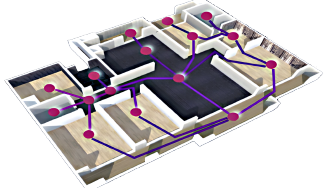
Description
IndoorGML is an OGC standard for an open data model and XML schema for indoor spatial information. It aims to provide a common framework of representation and exchange of indoor spatial information. IndoorGML focuses on modelling indoor spaces for navigation purposes.
Main concept
An important difference between indoor space and outdoor is that an indoor space is composed of complicated constraints such as corridors, doors, stairs, elevators and so on. There are five components that represent IndoorGML:
- Cellular space: indoor space as a set of cells, which are defined as the smallest organizational or structural unit of indoor space. Each cell has an identifier and boundary covering unique space.
- Semantic representation: covers important characteristics of cells. In IndoorGML, semantics is used for two purposes: classify cells and determine the connectivity between them.
- Geometric representation: is not a major focus of IndoorGML since 2D and 3D geometric representation are clearly defined by ISO 19107, CityGML and IFC. But, for the sake of self-completeness, the geometry of 2D or 3D object may be optionally defined within IndoorGML according to the data model defined by ISO 19107.
- Topological representation: is an essential component of cellular space and IndoorGML. The topological relationships, such as adjacency and connectivity, among indoor objects are encoded in a network. The network allows abstracting, simplifying and representing topological relationships among 3D spaces in indoor environments, such as rooms within a building.
- Multi-Layered Representation: a single indoor space is often semantically interpreted into different cellular spaces. For example, an indoor space is represented as a topographic cellular space composed of rooms, corridors and stairs, while it is also represented as different cellular spaces with WiFi coverage cells and RFID sensor coverage cells, respectively as the following figure. For this reason, IndoorGML supports multiple representation layers with different cellular spaces for an indoor space.
- IndoorGML 2.0 is currently prepared and will be released soon. See: Diakité, A. A., Zlatanova, S., Alattas, A. F. M., and Li, K. J., 2020, Towards IndoorGML 2.0: Updates and Case Studies illustrations, Int. Arch. Photogramm. Remote Sens. Spatial Inf. Sci., XLIII-B4-2020, 337–344, (doi)
For more information, please visit the links below.
People involved
| Participant’s details | Organisation |
|---|---|
| Prof. Sisi Zlatanova | UNSW, Built Environment, GRID |
| Prof. Ki-Joune Li | Pusan National University |
| Abdullah Alattas | Delft University of Technology |
| Dr Abdoulaye Diakite | UNSW, Built Environment, GRID |
| Mitko Aleksandrov | UNSW, Built Environment, GRID |
